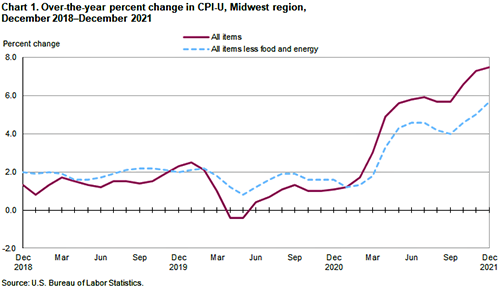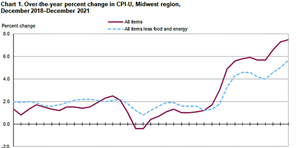KANSAS CITY, Kansas — Prices in the Midwest Region, as measured by the Consumer Price Index for All Urban Consumers (CPI-U), increased 0.3 percent in December, the U.S. Bureau of Labor Statistics reported Wednesday.
The food index rose 0.6 percent in December while the index for energy declined 2.1 percent as a result of lower gasoline prices. The all items less food and energy index increased 0.5 percent in December due to advances in the categories for new and used motor vehicles, medical care, household furnishings and operations, and recreation.
Over the last 12 months, the CPI-U rose 7.5 percent. The index for all items less food and energy increased 5.7 percent over the year. Energy prices jumped 30.6 percent, largely the result of an increase in the price of gasoline. Food prices increased 7.5 percent.

Food
Food prices rose 0.6 percent for the month of December. (See table 1.) Prices for food at home increased 0.6 percent, and prices for food away from home advanced 0.6 percent for the same period.
Over the year, food prices increased 7.5 percent. Prices for food at home advanced 7.4 percent since a year ago, and prices for food away from home increased 7.7 percent.
Energy
The energy index fell 2.1 percent over the month. The decrease was due to lower prices for gasoline (-4.0 percent) and to a lesser extent, a 0.8 percent drop in costs for natural gas service. The electricity index increased 0.2 percent in December.
Energy prices rose 30.6 percent over the year. Gasoline prices were up 48.8 percent compared to a year ago and natural gas service costs rose 33.7 percent over the year. Prices for electricity advanced 3.8 percent during the past year.
All items less food and energy
The index for all items less food and energy advanced 0.5 percent in December. Higher prices for new and used motor vehicles (2.0 percent), medical care (0.6 percent), household furnishings and operations (1.1 percent), and recreation (0.9 percent) were only partially offset by lower prices for apparel (-1.1 percent) and education and communication (-0.1 percent).
Over the year, the index for all items less food and energy increased 5.7 percent. Components contributing to the increase included new and used motor vehicles (20.2 percent), shelter (4.5 percent), and household furnishings and operations (9.1 percent).

